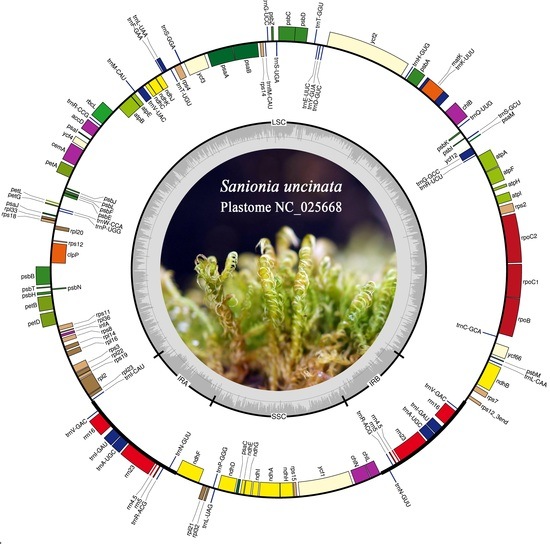The Complete Plastome Sequence of an Antarctic Bryophyte Sanionia uncinata (Hedw.) Loeske
Abstract
:1. Introduction
2. Results and Discussion
2.1. Overall Genome Organization
2.2. Comparison with Other Bryophyte Plastomes
2.3. Phylogenomic Analysis
2.4. Loss of rpoA and petN in the S. uncinata Plastome
2.5. Identification of Nuclear Genes Encoding rpoA and petN
2.6. Prediction of RNA Editing Sites of Chloroplast Genes
3. Materials and Methods
3.1. Ethics Statement
3.2. Plant Culture Conditions
3.3. Library Preparation and Sequencing
3.4. Assembly and Annotation
3.5. Genome Alignment
3.6. Phylogenetic Analysis
3.7. Prediction of RNA-Editing Sites
4. Conclusions
Supplementary Materials
Acknowledgments
Author Contributions
Conflicts of Interest
Abbreviations
| LSC | Large single copy |
| SSC | Small single copy |
| IR | Inverted repeat |
| Cp | Chloroplast |
| nuc | Nucleus |
| MP | Maximum parsimony |
| ML | Maximum likelihood |
| A | Adenine |
| T | Thymine |
| G | Guanine |
| C | cytosine |
References
- Bramley-Alves, J.; King, D.H.; Robinson, S.A.; Miller, R.E. Dominating the Antarctic environment: Bryophytes in a time of change. In Photosynthesis in Bryophytes and Early Land Plants; Hanson, D., Rice, S., Eds.; Springer Netherlands: Dordrecht, The Netherlands, 2014; pp. 309–324. [Google Scholar]
- Smith, R.L. Introduced plants in Antarctica: Potential impacts and conservation issues. Biol. Conserv. 1996, 76, 135–146. [Google Scholar] [CrossRef]
- Victoria, F.D.C.; Pereira, A.B.; da Costa, D.P. Composition and distribution of moss formations in the ice-free areas adjoining the Arctowski region, admiralty bay, King George Island, Antarctica. Iheringia Ser. Bot. 2009, 64, 81–91. [Google Scholar]
- Hedenäs, L. Global phylogeography in Sanionia uncinata (amblystegiaceae: Bryophyta). Bot. J. Linn. Soc. 2011, 168, 19–42. [Google Scholar] [CrossRef]
- Nakatsubo, T. Predicting the impact of climatic warming on the carbon balance of the moss Sanionia uncinata on a maritime Antarctic island. J. Plant Res. 2002, 115, 99–106. [Google Scholar] [CrossRef] [PubMed]
- Hokkanen, P.J. Environmental patterns and gradients in the vascular plants and bryophytes of eastern Fennoscandian herb-rich forests. For. Ecol. Manag. 2006, 229, 73–87. [Google Scholar] [CrossRef]
- Kushnevskaya, H.; Mirin, D.; Shorohova, E. Patterns of epixylic vegetation on spruce logs in late-successional boreal forests. For. Ecol. Manag. 2007, 250, 25–33. [Google Scholar] [CrossRef]
- Samecka-Cymerman, A.; Wojtuń, B.; Kolon, K.; Kempers, A. Sanionia uncinata (Hedw.) loeske as bioindicator of metal pollution in polar regions. Polar Biol. 2011, 34, 381–388. [Google Scholar] [CrossRef]
- Lud, D.; Moerdijk, T.; Van de Poll, W.; Buma, A.; Huiskes, A. DNA damage and photosynthesis in Antarctic and Arctic Sanionia uncinata (hedw.) Loeske under ambient and enhanced levels of UV-B radiation. Plant Cell Environ. 2002, 25, 1579–1589. [Google Scholar] [CrossRef]
- Lud, D.; Schlensog, M.; Schroeter, B.; Huiskes, A. The influence of UV-B radiation on light-dependent photosynthetic performance in Sanionia uncinata (Hedw.) Loeske in Antarctica. Polar Biol. 2003, 26, 225–232. [Google Scholar]
- Zúñiga-González, P.; Zúñiga, G.E.; Pizarro, M.; Casanova-Katny, A. Soluble carbohydrate content variation in Sanionia uncinata and polytrichastrum alpinum, two Antarctic mosses with contrasting desiccation capacities. Biol. Res. 2016, 49, 6. [Google Scholar] [CrossRef] [PubMed]
- Van Gaalen, K.E.; Flanagan, L.B.; Peddle, D.R. Photosynthesis, chlorophyll fluorescence and spectral reflectance in sphagnum moss at varying water contents. Oecologia 2007, 153, 19–28. [Google Scholar] [CrossRef] [PubMed]
- Oliver, M.J.; Murdock, A.G.; Mishler, B.D.; Kuehl, J.V.; Boore, J.L.; Mandoli, D.F.; Everett, K.D.; Wolf, P.G.; Duffy, A.M.; Karol, K.G. Chloroplast genome sequence of the moss Tortula ruralis: Gene content, polymorphism and structural arrangement relative to other green plant chloroplast genomes. BMC Genom. 2010, 11, 143. [Google Scholar] [CrossRef] [PubMed]
- Gray, M.W. The evolutionary origins of organelles. Trends Genet. 1989, 5, 294–299. [Google Scholar] [CrossRef]
- Howe, C.J.; Barbrook, A.C.; Koumandou, V.L.; Nisbet, R.E.R.; Symington, H.A.; Wightman, T.F. Evolution of the chloroplast genome. Philos. Trans. R. Soc. Lond. B Biol. Sci. 2003, 358, 99–107. [Google Scholar] [CrossRef] [PubMed]
- Sugiura, M. The chloroplast chromosomes in land plants. Annu. Rev. Cell Biol. 1989, 5, 51–70. [Google Scholar] [CrossRef] [PubMed]
- Neuhaus, H.; Emes, M. Nonphotosynthetic metabolism in plastids. Annu. Rev. Plant Biol. 2000, 51, 111–140. [Google Scholar] [CrossRef] [PubMed]
- Daniell, H.; Lin, C.-S.; Yu, M.; Chang, W.-J. Chloroplast genomes: Diversity, evolution and applications in genetic engineering. Genome Biol. 2016, 17, 134. [Google Scholar] [CrossRef] [PubMed]
- Chumley, T.W.; Palmer, J.D.; Mower, J.P.; Fourcade, H.M.; Calie, P.J.; Boore, J.L.; Jansen, R.K. The complete chloroplast genome sequence of pelargonium× hortorum: Organization and evolution of the largest and most highly rearranged chloroplast genome of land plants. Mol. Biol. Evol. 2006, 23, 2175–2190. [Google Scholar] [CrossRef] [PubMed]
- Karol, K.G.; Arumuganathan, K.; Boore, J.L.; Duffy, A.M.; Everett, K.D.; Hall, J.D.; Hansen, S.K.; Kuehl, J.V.; Mandoli, D.F.; Mishler, B.D. Complete plastome sequences of Equisetum arvense and isoetes flaccida: Implications for phylogeny and plastid genome evolution of early land plant lineages. BMC Evol. Biol. 2010, 10, 321. [Google Scholar] [CrossRef] [PubMed]
- Coordinators, N.R. Database resources of the National Center for Biotechnology Information. Nucleic Acids Res. 2016, 44, D7–D19. [Google Scholar]
- Sugiura, C.; Kobayashi, Y.; Aoki, S.; Sugita, C.; Sugita, M. Complete chloroplast DNA sequence of the moss Physcomitrella patens: Evidence for the loss and relocation of rpoA from the chloroplast to the nucleus. Nucleic Acids Res. 2003, 31, 5324–5331. [Google Scholar] [CrossRef] [PubMed]
- Bell, N.E.; Boore, J.L.; Mishler, B.D.; Hyvönen, J. Organellar genomes of the four-toothed moss, Tetraphis pellucida. BMC Genom. 2014, 15, 383. [Google Scholar] [CrossRef] [PubMed]
- Lewis, L.R.; Liu, Y.; Rozzi, R.; Goffinet, B. Infraspecific variation within and across complete organellar genomes and nuclear ribosomal repeats in a moss. Mol. Phylogenet. Evol. 2016, 96, 195–199. [Google Scholar] [CrossRef] [PubMed]
- Kugita, M.; Kaneko, A.; Yamamoto, Y.; Takeya, Y.; Matsumoto, T.; Yoshinaga, K. The complete nucleotide sequence of the hornwort (Anthoceros formosae) chloroplast genome: Insight into the earliest land plants. Nucleic Acids Res. 2003, 31, 716–721. [Google Scholar] [CrossRef] [PubMed]
- Ohyama, K.; Fukuzawa, H.; Kohchi, T.; Shirai, H.; Sano, T.; Sano, S.; Umesono, K.; Shiki, Y.; Takeuchi, M.; Chang, Z. Chloroplast gene organization deduced from complete sequence of liverwort Marchantia polymorpha chloroplast DNA. Nature 1986, 322, 572–574. [Google Scholar] [CrossRef]
- Wakasugi, T.; Tsudzuki, T.; Sugiura, M. The genomics of land plant chloroplasts: Gene content and alteration of genomic information by RNA editing. Photosynth Res. 2001, 70, 107–118. [Google Scholar] [CrossRef] [PubMed]
- Lee, J.; Kang, Y.; Shin, S.C.; Park, H.; Lee, H. Combined analysis of the chloroplast genome and transcriptome of the Antarctic vascular plant Deschampsia antarctica Desv. PLoS ONE 2014, 9, e92501. [Google Scholar] [CrossRef] [PubMed]
- Maul, J.E.; Lilly, J.W.; Cui, L.; Miller, W.; Harris, E.H.; Stern, D.B. The Chlamydomonas reinhardtii plastid chromosome islands of genes in a sea of repeats. Plant Cell 2002, 14, 2659–2679. [Google Scholar] [CrossRef] [PubMed]
- Turmel, M.; Pombert, J.-F.; Charlebois, P.; Otis, C.; Lemieux, C. The green algal ancestry of land plants as revealed by the chloroplast genome. Int. J. Plant Sci. 2007, 168, 679–689. [Google Scholar] [CrossRef]
- Lohse, M.; Drechsel, O.; Kahlau, S.; Bock, R. OrganellarGenomeDRAW—A suite of tools for generating physical maps of plastid and mitochondrial genomes and visualizing expression data sets. Nucleic Acids Res. 2013, 41, W575–W581. [Google Scholar] [CrossRef] [PubMed]
- Turmel, M.; Otis, C.; Lemieux, C. The chloroplast and mitochondrial genome sequences of the charophyte Chaetosphaeridium globosum: Insights into the timing of the events that restructured organelle DNAs within the green algal lineage that led to land plants. Proc. Natl. Acad. Sci. USA 2002, 99, 11275–11280. [Google Scholar] [CrossRef] [PubMed]
- Jansen, R.K.; Ruhlman, T.A. Plastid genomes of seed plants. In Genomics of Chloroplasts and Mitochondria; Bock, R., Knoop, V., Eds.; Springer Netherlands: Dordrecht, The Netherlands, 2012; pp. 103–126. [Google Scholar]
- Barthet, M.M.; Hilu, K.W. Expression of matK: Functional and evolutionary implications. Am. J. Bot. 2007, 94, 1402–1412. [Google Scholar] [CrossRef] [PubMed]
- Quax, T.E.; Claassens, N.J.; Söll, D.; van der Oost, J. Codon bias as a means to fine-tune gene expression. Mol. Cell 2015, 59, 149–161. [Google Scholar] [CrossRef] [PubMed]
- Hausner, G.; Olson, R.; Simon, D.; Johnson, I.; Sanders, E.R.; Karol, K.G.; McCourt, R.M.; Zimmerly, S. Origin and evolution of the chloroplast trnK (matK) intron: A model for evolution of group II intron RNA structures. Mol. Biol. Evol. 2005, 23, 380–391. [Google Scholar] [CrossRef] [PubMed]
- Gao, L.; Su, Y.J.; Wang, T. Plastid genome sequencing, comparative genomics and phylogenomics: Current status and prospects. J. Syst. Evol. 2010, 48, 77–93. [Google Scholar] [CrossRef]
- Shaw, J.; Lickey, E.B.; Schilling, E.E.; Small, R.L. Comparison of whole chloroplast genome sequences to choose noncoding regions for phylogenetic studies in angiosperms: The tortoise and the hare III. Am. J. Bot. 2007, 94, 275–288. [Google Scholar] [CrossRef] [PubMed]
- Cox, C.J.; Goffinet, B.; Wickett, N.J.; Boles, S.B.; Shaw, A.J. Moss diversity: A molecular phylogenetic analysis of genera. Phytotaxa 2014, 9, 175–195. [Google Scholar] [CrossRef]
- Goffinet, B.; Wickett, N.J.; Werner, O.; Ros, R.M.; Shaw, A.J.; Cox, C.J. Distribution and phylogenetic significance of the 71-kb inversion in the plastid genome in Funariidae (Bryophyta). Am. J. Bot. 2007, 99, 747–753. [Google Scholar] [CrossRef] [PubMed]
- Wicke, S.; Schneeweiss, G.M.; Müller, K.F.; Quandt, D. The evolution of the plastid chromosome in land plants: Gene content, gene order, gene function. Plant Mol. Biol. 2011, 76, 273–297. [Google Scholar] [CrossRef] [PubMed]
- Martin, W.; Rujan, T.; Richly, E.; Hansen, A.; Cornelsen, S.; Lins, T.; Leister, D.; Stoebe, B.; Hasegawa, M.; Penny, D. Evolutionary analysis of Arabidopsis, cyanobacterial and chloroplast genomes reveals plastid phylogeny and thousands of cyanobacterial genes in the nucleus. Proc. Natl. Acad. Sci. USA 2002, 99, 12246–12251. [Google Scholar] [CrossRef] [PubMed]
- Martin, W.; Stoebe, B.; Goremykin, V.; Hansmann, S.; Hasegawa, M.; Kowallik, K.V. Gene transfer to the nucleus and the evolution of chloroplasts. Nature 1998, 393, 162–165. [Google Scholar] [CrossRef] [PubMed]
- Rensing, S.A.; Lang, D.; Zimmer, A.D.; Terry, A.; Salamov, A.; Shapiro, H.; Nishiyama, T.; Perroud, P.-F.; Lindquist, E.A.; Kamisugi, Y. The Physcomitrella genome reveals evolutionary insights into the conquest of land by plants. Science 2008, 319, 64–69. [Google Scholar] [CrossRef] [PubMed]
- Petersen, T.N.; Brunak, S.; von Heijne, G.; Nielsen, H. SignalP 4.0: Discriminating signal peptides from transmembrane regions. Nat. Methods 2011, 8, 785–786. [Google Scholar] [CrossRef] [PubMed]
- Wakasugi, T.; Hirose, T.; Horihata, M.; Tsudzuki, T.; Kössel, H.; Sugiura, M. Creation of a novel protein-coding region at the RNA level in black pine chloroplasts: The pattern of RNA editing in the gymnosperm chloroplast is different from that in angiosperms. Proc. Natl. Acad. Sci. USA 1996, 93, 8766–8770. [Google Scholar] [CrossRef] [PubMed]
- Zandueta-Criado, A.; Bock, R. Surprising features of plastid ndhD transcripts: Addition of non-encoded nucleotides and polysome association of mRNAs with an unedited start codon. Nucleic Acids Res. 2004, 32, 542–550. [Google Scholar] [CrossRef] [PubMed]
- Covello, P.S.; Gray, M.W. RNA editing in plant mitochondria. Nature 1989, 341, 662–666. [Google Scholar] [CrossRef] [PubMed]
- Gualberto, J.M.; Lamattina, L.; Bonnard, G.; Weil, J.-H.; Grienenberger, J.-M. RNA editing in wheat mitochondria results in the conservation of protein sequences. Nature 1989, 341, 660–662. [Google Scholar] [CrossRef] [PubMed]
- Hiesel, R.; Wissinger, B.; Schuster, W.; Brennicke, A. RNA editing in plant mitochondria. Science 1989, 246, 1632–1634. [Google Scholar] [CrossRef] [PubMed]
- Hoch, B.; Maier, R.M.; Appel, K.; Igloi, G.L.; Kössel, H. Editing of a chloroplast mRNA by creation of an initiation codon. Nature 1991, 353, 178–180. [Google Scholar] [CrossRef] [PubMed]
- Freyer, R.; Kiefer-Meyer, M.-C.; Kössel, H. Occurrence of plastid RNA editing in all major lineages of land plants. Proc. Natl. Acad. Sci. USA 1997, 94, 6285–6290. [Google Scholar] [CrossRef] [PubMed]
- Stern, D.B.; Goldschmidt-Clermont, M.; Hanson, M.R. Chloroplast RNA metabolism. Annu. Rev. Plant Biol. 2010, 61, 125–155. [Google Scholar] [CrossRef] [PubMed]
- Mower, J.P. The prep suite: Predictive RNA editors for plant mitochondrial genes, chloroplast genes and user-defined alignments. Nucleic Acids Res. 2009, 37, W253–W259. [Google Scholar] [CrossRef] [PubMed]
- Lenz, H.; Knoop, V. PREPACT 2.0: Predicting C-to-U and U-to-C RNA editing in organelle genome sequences with multiple references and curated RNA editing annotation. Bioinform. Biol. Insights 2013, 7, 1–19. [Google Scholar] [CrossRef] [PubMed]
- Bock, R. Sense from nonsense: How the genetic information of chloroplastsis altered by RNA editing. Biochimie 2000, 82, 549–557. [Google Scholar] [CrossRef]
- Chen, H.; Deng, L.; Jiang, Y.; Lu, P.; Yu, J. RNA editing sites exist in protein-coding genes in the chloroplast genome of Cycas taitungensis. J. Integr. Plant Biol. 2011, 53, 961–970. [Google Scholar] [CrossRef] [PubMed]
- Wyman, S.K.; Jansen, R.K.; Boore, J.L. Automatic annotation of organellar genomes with DOGMA. Bioinformatics 2004, 20, 3252–3255. [Google Scholar] [CrossRef] [PubMed]
- Schattner, P.; Brooks, A.N.; Lowe, T.M. The tRNAscan-SE, snoscan and snoGPS web servers for the detection of tRNAs and snoRNAs. Nucleic Acids Res. 2005, 33, W686–W689. [Google Scholar] [CrossRef] [PubMed]
- Frazer, K.A.; Pachter, L.; Poliakov, A.; Rubin, E.M.; Dubchak, I. Vista: Computational tools for comparative genomics. Nucleic Acids Res. 2004, 32, W273–W279. [Google Scholar] [CrossRef] [PubMed]
- Kumar, S.; Stecher, G.; Tamura, K. MEGA7: Molecular evolutionary genetics analysis version 7.0 for bigger datasets. Mol. Biol. Evol. 2016, 33, 1870–1874. [Google Scholar] [CrossRef] [PubMed]
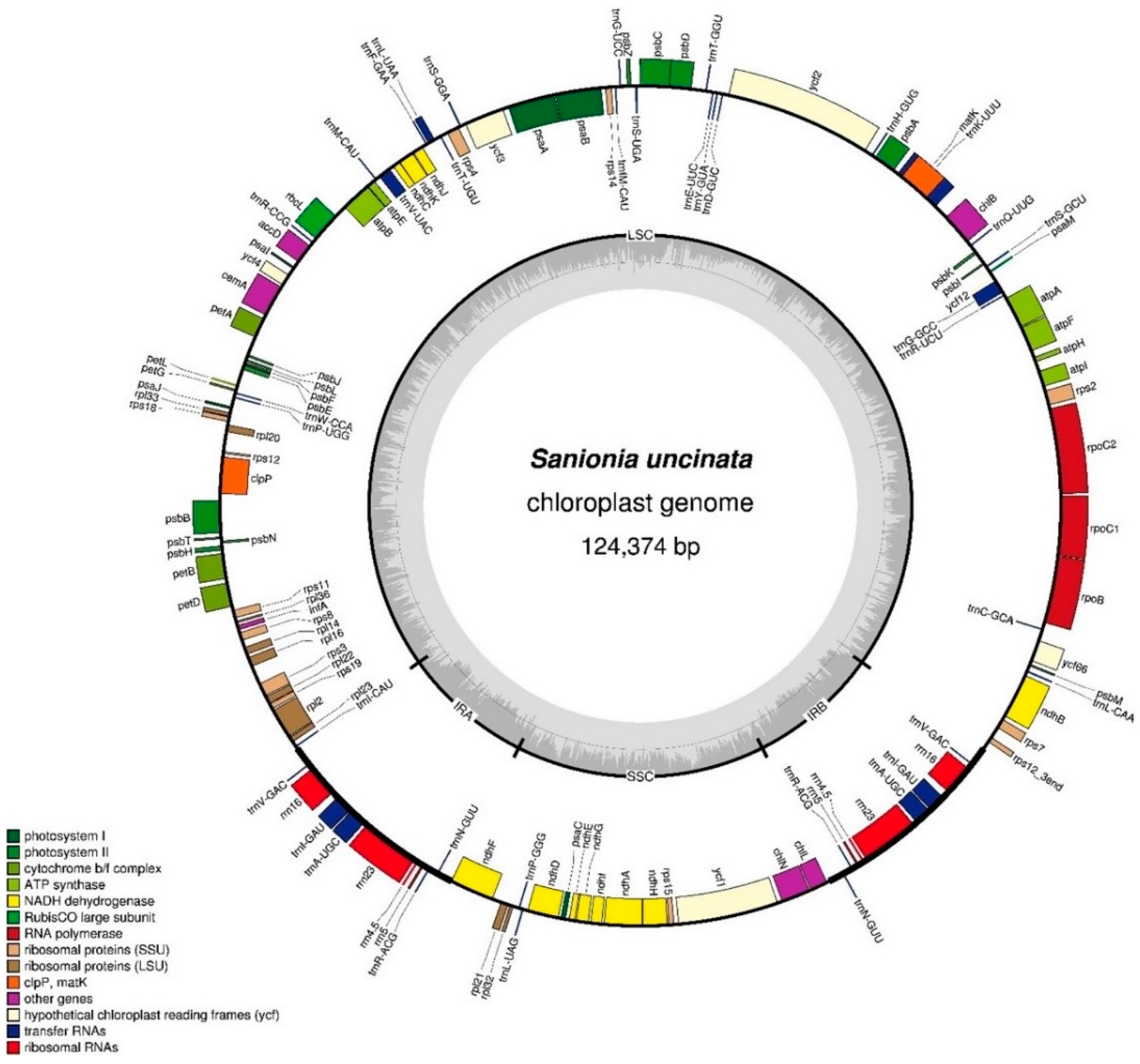
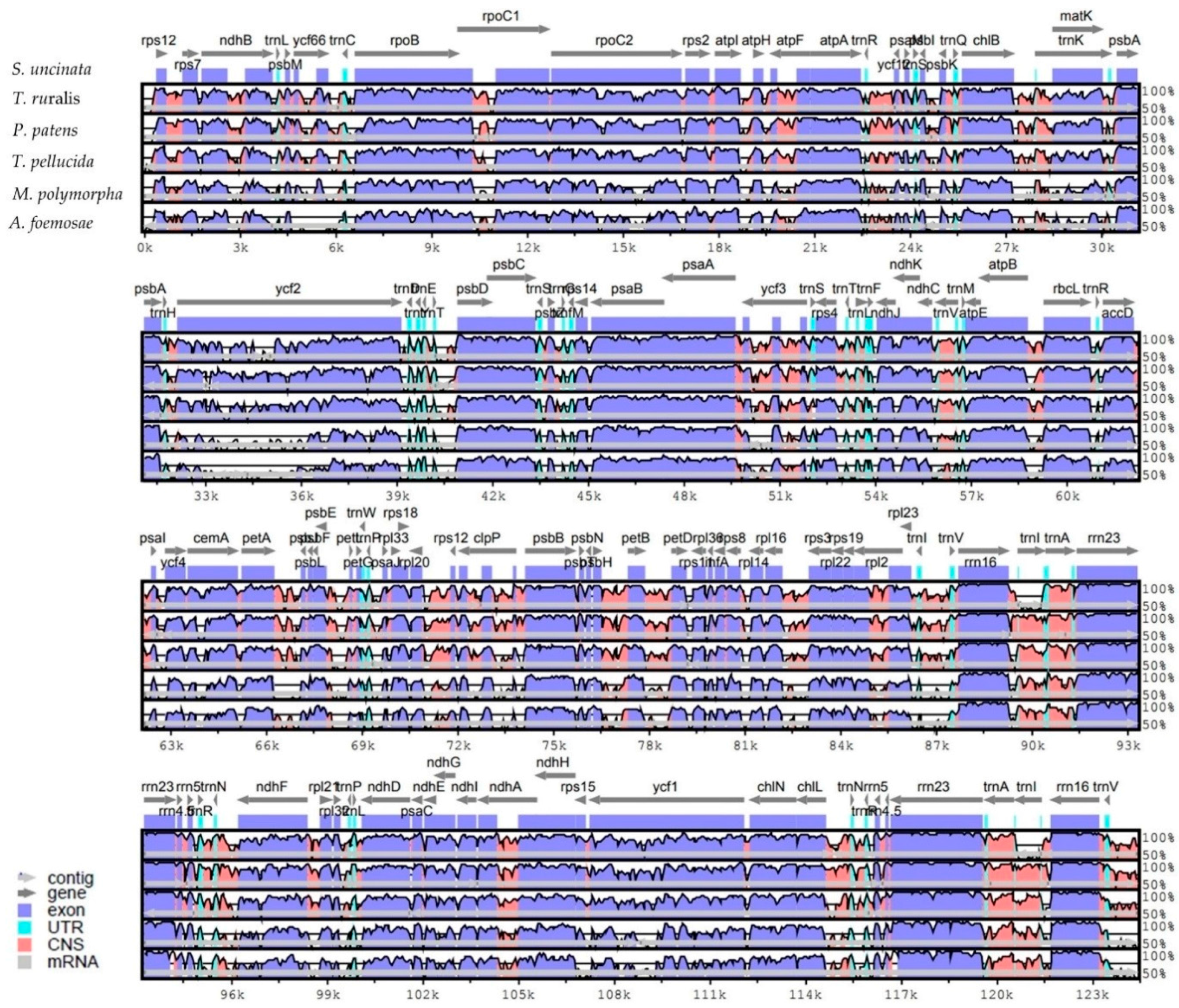
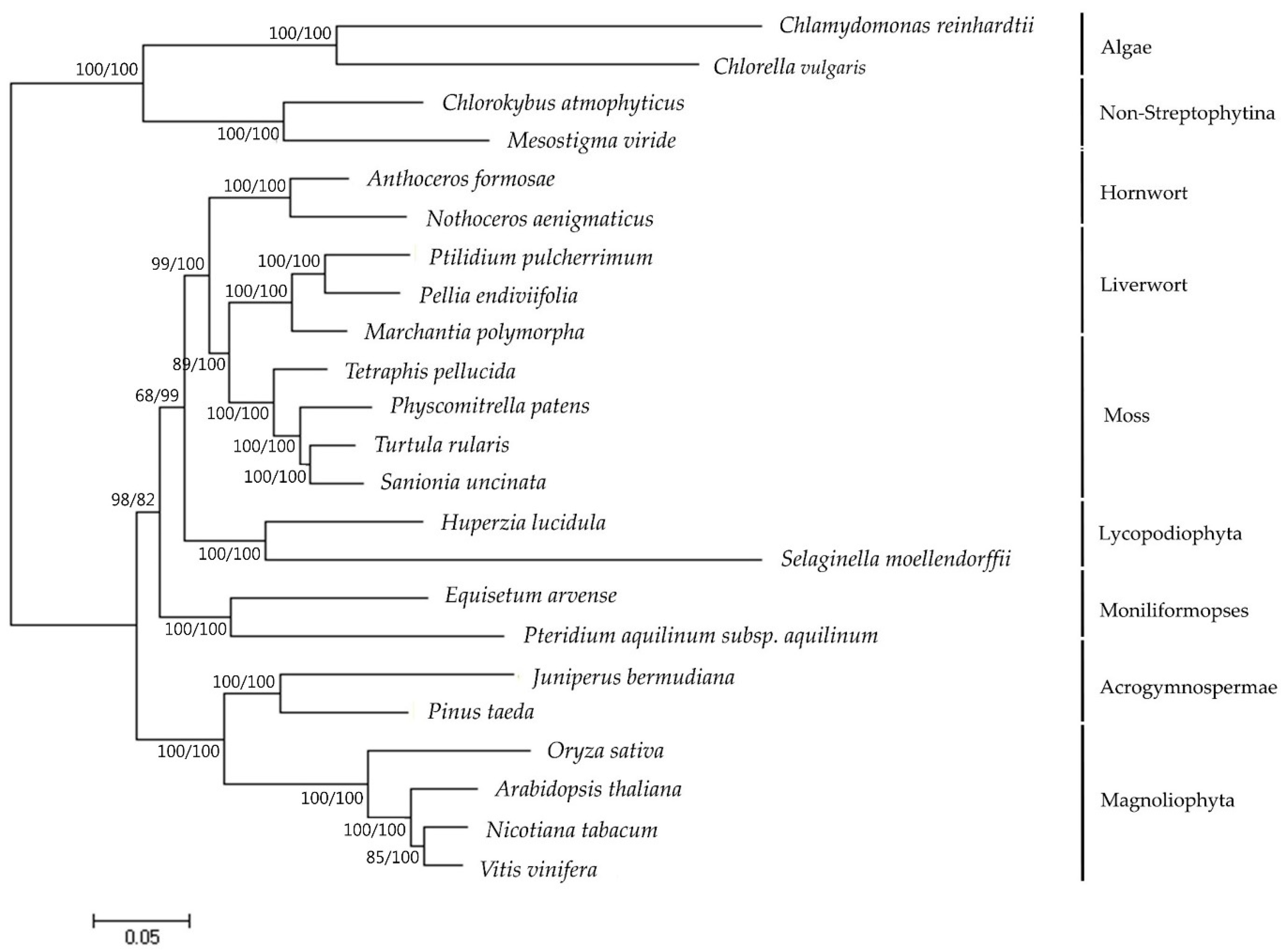
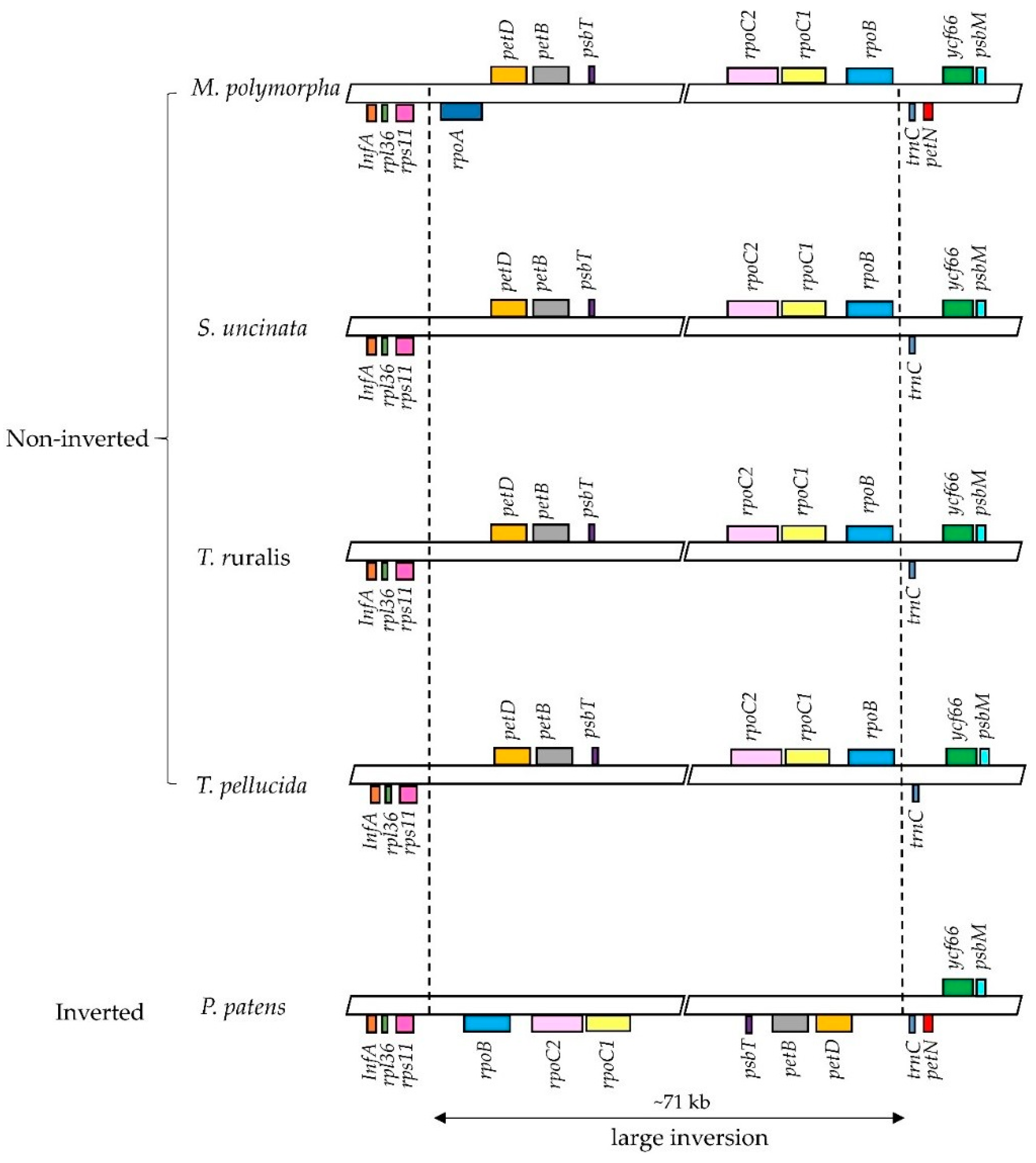
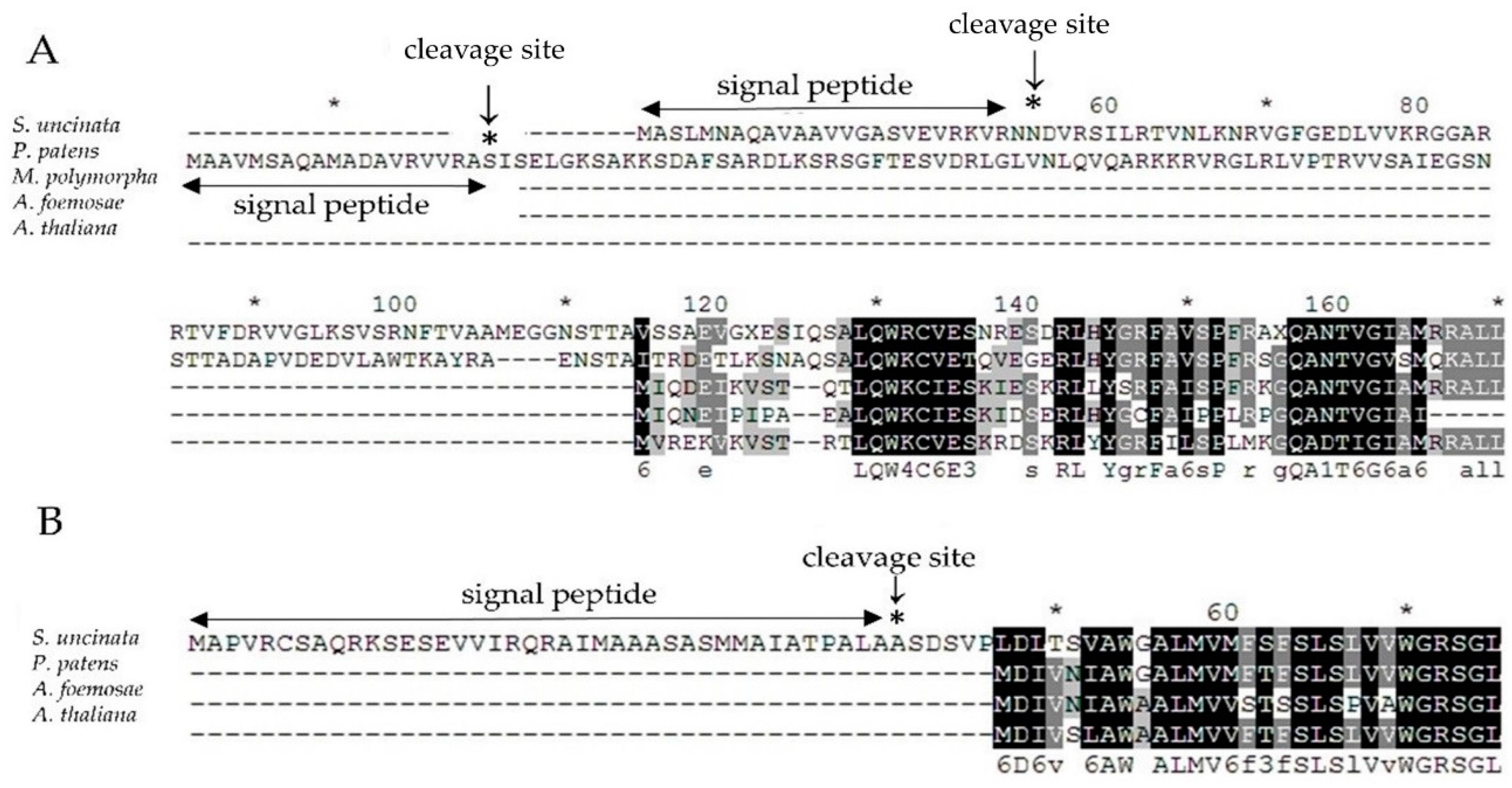
| Gene Products | Genes |
|---|---|
| Photosystem I | psaA, B, C, I, J, M |
| Photosystem II | psbA, B, C, D, E, F, H, I, J, K, L, M, N, T, Z |
| Cytochrome b6/f | petA, B a, D a, G, L |
| ATP synthase | atpA, B, E, F a, H, I |
| Translation factor | infA |
| Chlorophyll biosynthesis | chlB, L, N |
| Rubisco | rbcL |
| NADH oxidoreductase | ndhA a, B a, C, D, E, F, G, H, I, J, K |
| Large subunit ribosomal proteins | rpl2 a, 14, 16 a, 20, 21, 22, 23, 32, 33, 36 |
| Small subunit ribosomal proteins | rps2, 3, 4, 7, 8, 11, 12 a,b, 14, 15, 18, 19 |
| RNAP | rpoB, C1 a, C2 |
| Other proteins | accD, cemA, clpP c, matK |
| Proteins of unknown function | ycf1, 2, 3 c, 4, 12, 66 a |
| Ribosomal | rrn4.5 d, 5 d, 16 d, 23 d |
| Transfer RNAs | trnA(UGC) a,d, C(GCA), D(GUC), E(UUC), F(GAA), G(UCC) a, G(UCC), H(GUG), I(CAU), I(GAU) a,d, K(UUU) a, L(CAA), L(UAA) a, L(UAG), fM(CAU), M(CAU), N(GUU) d, P(UGG), P(GGG), Q(UUG), R(ACG) d, R(CCG), R(UCU), S(GCU), S(GGA), S(UGA), T(GGU), T(UGU), V(GAC) d, V(UAC) a, W(CCA), Y(GUA) |
| Gene | Location | Length (bp) | ||||
|---|---|---|---|---|---|---|
| Exon I | Intron I | Exon II | Intron II | Exon III | ||
| rps12 | LSC | 114 | - | 270 | ||
| ndhB | LSC | 729 | 629 | 780 | ||
| ycf66 | LSC | 106 | 591 | 320 | ||
| rpoC1 | LSC | 423 | 789 | 1614 | ||
| atpF | LSC | 411 | 654 | 135 | ||
| ycf3 | LSC | 126 | 684 | 228 | 739 | 153 |
| clpP | LSC | 69 | 687 | 291 | 483 | 234 |
| rpl2 | LSC | 396 | 637 | 438 | ||
| ndhA | SSC | 556 | 731 | 551 | ||
| trnK-UUU | LSC | 37 | 2272 | 42 | ||
| trnL-UAA | LSC | 38 | 262 | 50 | ||
| trnV-UAC | LSC | 37 | 542 | 37 | ||
| trnI-GAU | IR | 42 | 769 | 35 | ||
| trnA-UGC | IR | 38 | 763 | 35 | ||
| Amino Acid | Codon | No. * | tRNA | Amino Acid | Codon | No. * | tRNA |
|---|---|---|---|---|---|---|---|
| Phe | UUU | 2862 | Tyr | UAU | 1492 | ||
| Phe | UUC | 916 | trnF-GAA | Tyr | UAC | 578 | trnY-GUA |
| Leu | UUG | 688 | trnL-UAA | Stop | UAA | 1772 | |
| Leu | UUA | 1766 | trnL-CAA | Stop | UAG | 577 | |
| Leu | CUG | 252 | His | CAU | 550 | ||
| Leu | CUA | 591 | trnL-UAG | His | CAC | 224 | trnH-GUG |
| Leu | CUU | 741 | Gln | CAA | 685 | trnQ-UUG | |
| Leu | CUC | 305 | Gln | CAG | 273 | ||
| Ile | AUG | 1582 | trnI-CAU | Asn | AAU | 1878 | |
| Ile | AUU | 1943 | Asn | AAC | 665 | trnN-GUU | |
| Ile | AUC | 629 | trnI-GAU | Lys | AAA | 2942 | trnK-UUU |
| Met | AUG | 515 | trnfM-CAU | Lys | AAG | 768 | |
| Val | GUG | 244 | Asp | GAU | 619 | ||
| Val | GUA | 588 | trnV-UAC | Asp | GAC | 210 | trnD-GUC |
| Val | GUU | 652 | Glu | GAA | 845 | trnE-UUC | |
| Val | GUC | 237 | trnV-GAC | Glu | GAG | 286 | |
| Ser | AGU | 579 | Cys | UGU | 515 | ||
| Ser | AGC | 470 | trnS-GCU | Cys | UGC | 362 | trnC-GCA |
| Ser | UCG | 272 | Stop | UGA | 657 | ||
| Ser | UCA | 643 | trnS-UGA | Trp | UGG | 455 | trnW-CCA |
| Pro | CCG | 169 | Arg | AGG | 387 | ||
| Pro | CCA | 429 | trnP-UGG | Arg | AGA | 732 | trnR-UCU |
| Pro | CCU | 423 | Arg | CGG | 164 | trnR-CCG | |
| Pro | CCC | 230 | trnP-GGG | Arg | CGA | 322 | |
| Thr | ACG | 228 | Arg | CGU | 270 | trnR-ACG | |
| Thr | ACA | 508 | trnT-UGU | Arg | CGC | 143 | |
| Thr | ACU | 561 | Ser | UCU | 735 | ||
| Thr | ACC | 363 | trnT-GGU | Ser | UCC | 419 | trnS-GGA |
| Ala | GCG | 155 | Gly | GGG | 426 | ||
| Ala | GCA | 367 | trnA-UGC | Gly | GGA | 465 | trnG-UCC |
| Ala | GCU | 413 | Gly | GGU | 653 | ||
| Ala | GCC | 514 | Gly | GGC | 237 |
| Plants * | Genome Size (bp) | petN | rpoA | ccsA | cysA | cysT | ycf66 | matK | rps15 | trnP-GGG | |
|---|---|---|---|---|---|---|---|---|---|---|---|
| Alga | Chlorella vulgaris | 150,613 | - | + | + | + | + | - | - | - | - |
| Hornwort | Anthoceros formosae | 161,162 | + | + | + | + | + | - | Ψ | Ψ | + |
| Liverwort | Marchantia polymorpha | 121,024 | + | + | + | + | + | + | + | + | Ψ |
| Moss | Tetraphis pellucida | 127,489 | - | - | - | - | - | + | + | + | - |
| Moss | Physcomitrella patens | 122,890 | + | - | - | - | - | + | + | + | - |
| Moss | Tortula rularis | 122,630 | - | - | - | - | - | + | + | + | + |
| Moss | Sanionia uncinata | 124,374 | - | - | - | - | - | + | + | + | + |
| Lycopodiophyta | Huperzia lucidula | 154,373 | + | + | + | - | - | + | + | + | + |
| Moniliformopses | Equisetum arvense | 133,309 | + | + | + | - | - | + | + | + | + |
| Acrogymnospermae | Pinus thunbergii | 116,635 | + | + | + | - | - | - | + | + | + |
| Magnoliophyta | Arabidopsis thaliana | 154,515 | + | + | + | - | - | - | + | + | - |
© 2018 by the authors. Licensee MDPI, Basel, Switzerland. This article is an open access article distributed under the terms and conditions of the Creative Commons Attribution (CC BY) license (http://creativecommons.org/licenses/by/4.0/).
Share and Cite
Park, M.; Park, H.; Lee, H.; Lee, B.-h.; Lee, J. The Complete Plastome Sequence of an Antarctic Bryophyte Sanionia uncinata (Hedw.) Loeske. Int. J. Mol. Sci. 2018, 19, 709. https://doi.org/10.3390/ijms19030709
Park M, Park H, Lee H, Lee B-h, Lee J. The Complete Plastome Sequence of an Antarctic Bryophyte Sanionia uncinata (Hedw.) Loeske. International Journal of Molecular Sciences. 2018; 19(3):709. https://doi.org/10.3390/ijms19030709
Chicago/Turabian StylePark, Mira, Hyun Park, Hyoungseok Lee, Byeong-ha Lee, and Jungeun Lee. 2018. "The Complete Plastome Sequence of an Antarctic Bryophyte Sanionia uncinata (Hedw.) Loeske" International Journal of Molecular Sciences 19, no. 3: 709. https://doi.org/10.3390/ijms19030709




